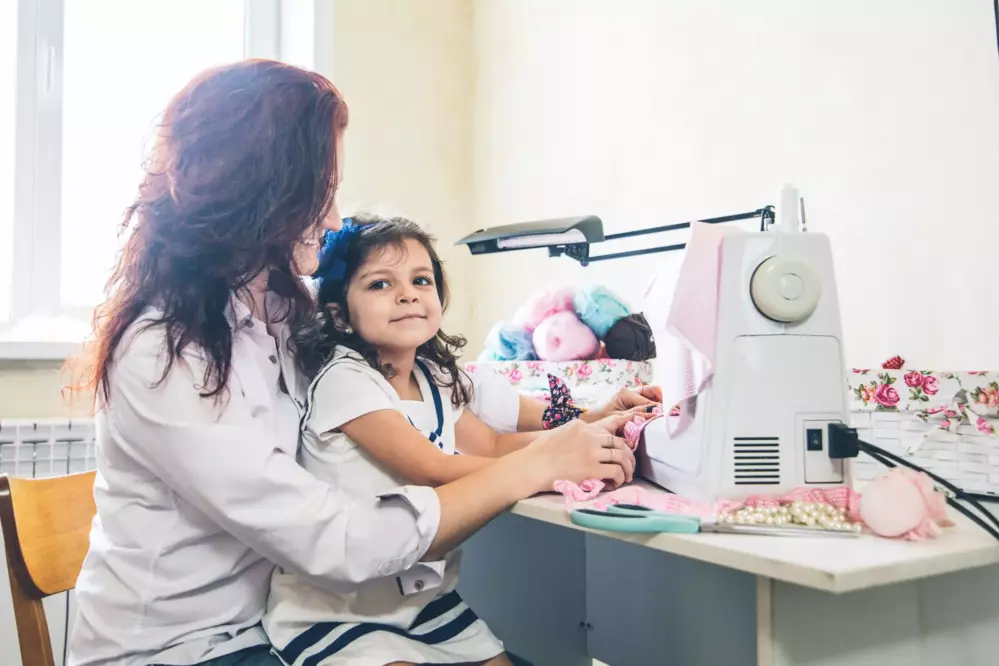6 Safety Tips for Sewing with Kids
2019-08-30
Whether you're teaching your child to sew, or you're worried about them getting into your needles, you need to implement a few basic safety standards. Of course, you also don't want to scare them off from learning to sew, so you may have a delicate line to walk.
Usually, the most pertinent question is, what is an appropriate age to learn how to sew? You can begin introducing your child to the materials as early as age three, but maybe not trust them with a needle until much later. The primary concern that most parents have is their kid's natural urge to rush and the many accidents that can come with that. Follow these essential safety tips to ensure that your children will have a fun and safe experience learning how to sew.
Ask the Child to Watch and Wait
If you're teaching a child at home, then you may have one or more machines. Carefully choose the machine that you will use for teaching (more on this in a moment). If you have a classroom of kids, then be sure that you have fewer sewing machines than you do students.
The reason for this is so you can always have someone watching and waiting, or someone sewing. You can either attentively watch a single child, or in a classroom setting, you can have the other children gather around the person sewing collectively. Students take away a lot from hands-on experience, but they do very well at watching too.
When children watch a skilled adult, they can see good habits in motion. They also get to see an adult make mistakes and correct them. As children watch other children, they are able to point out when those kids aren't following the rules. If a child sees another trying to thread a needle with the machine on, they will be quick to tattle.
Choose Your Sewing Machines Carefully
Many sewing machines have three speeds: slow, moderate, and fast. Use these types of machines when working with children. It's much safer for both of you as you can see and respond quickly, preventing possible damage to the child or machine. Inform them that they will move up in speed as their skill progresses and not sooner.
Mark Out the Danger Zone
Whether you use bright and colorful Washi tape or color in lines with a marker, you need to mark out the danger zone. Most adult fingers won't fit under a presser foot. However, tiny fingers will, and it's a tragic event when a child has a needle go through their finger. Make a clear zone around the bobbin case as well as the throat plate. Then create a strict rule that there cannot be any fingers in that zone.
Implement Good Needle Handling Practices Early
Children threading a needle, whether on a machine or for the hand stitching can make any adult nervous. You see their tiny hands maneuvering a very sharp object and you start thinking of all the things that could go wrong. You know they just aren't capable of the level of precision necessary for the task, until they finally manage it.
So, to help them reach this monumental accomplishment, you need to step back and let them try. However, you can still create a safe environment for them. Start by unplugging the machine. It is not enough to just switch it off, so be sure to disconnect the power. Children play game, and goof around so when threading on a machine, turn the power off.
When threading a needle for hand stitching have them put the tip into a pincushion. The traditional tomatoes have a tiny chili-shaped friend, and they can insert the tip of their needle into that for better handling. It also means that if they drop the needle, they can find it quickly.
Create Clear Rules for Using Scissors
You need something more than "no running." Post very clear and single-sentenced rules about using scissors. You might say, "When walking, the blade must be in your hand," or "Only cutting into the fabric and on a table." The more rules you make about scissors, the better, but make sure that each rule is only one sentence. Small children retain these quick statements much better long drawn out lectures.
Pickup and Store Pins Immediately
Leave no pin on the ground! Teach children that the moment they drop a pin or needle they need to stop what they're doing and find it. Teach them tricks such as using a magnet to find lost needs, or to keep pin cushions on the side of the machine. Help them by making it easier for the needle to stay in a safe place.
When sewing with small children, safety should be your top priority. However, be sure you also make the experience fun and creative so you can both enjoy it for years to come.





